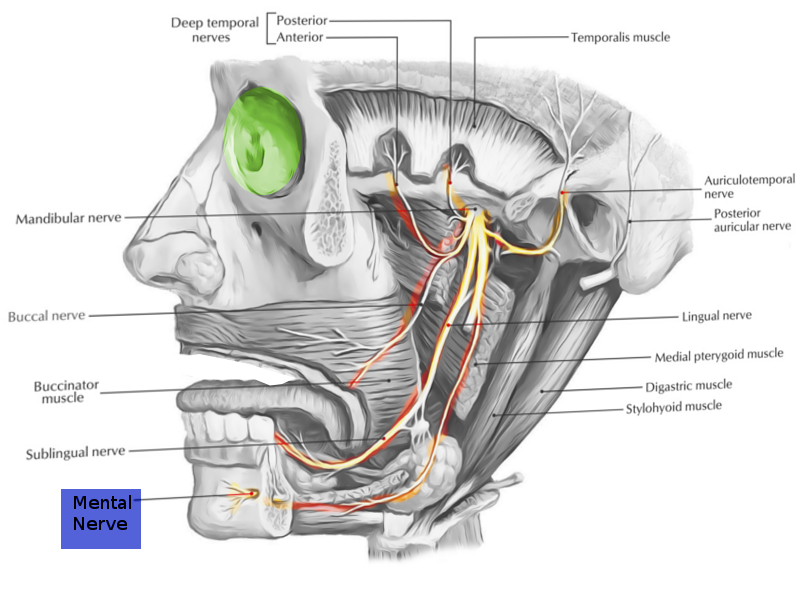[2]
Khalil H. A basic review on the inferior alveolar nerve block techniques. Anesthesia, essays and researches. 2014 Jan-Apr:8(1):3-8. doi: 10.4103/0259-1162.128891. Epub
[PubMed PMID: 25886095]
[3]
Lee MH, Kim HJ, Kim DK, Yu SK. Histologic features and fascicular arrangement of the inferior alveolar nerve. Archives of oral biology. 2015 Dec:60(12):1736-41. doi: 10.1016/j.archoralbio.2015.09.007. Epub 2015 Sep 11
[PubMed PMID: 26433190]
[4]
Wolf KT, Brokaw EJ, Bell A, Joy A. Variant Inferior Alveolar Nerves and Implications for Local Anesthesia. Anesthesia progress. 2016 Summer:63(2):84-90. doi: 10.2344/0003-3006-63.2.84. Epub
[PubMed PMID: 27269666]
[5]
Iwanaga J, Saga T, Tabira Y, Nakamura M, Kitashima S, Watanabe K, Kusukawa J, Yamaki K. The clinical anatomy of accessory mental nerves and foramina. Clinical anatomy (New York, N.Y.). 2015 Oct:28(7):848-56. doi: 10.1002/ca.22597. Epub 2015 Aug 9
[PubMed PMID: 26201838]
[6]
Mraiwa N, Jacobs R, van Steenberghe D, Quirynen M. Clinical assessment and surgical implications of anatomic challenges in the anterior mandible. Clinical implant dentistry and related research. 2003:5(4):219-25
[PubMed PMID: 15127992]
[7]
Greenstein G,Tarnow D, The mental foramen and nerve: clinical and anatomical factors related to dental implant placement: a literature review. Journal of periodontology. 2006 Dec
[PubMed PMID: 17209776]
[8]
Driscoll CF. Bifid mandibular canal. Oral surgery, oral medicine, and oral pathology. 1990 Dec:70(6):807
[PubMed PMID: 2263349]
[9]
Dario LJ. Implant placement above a bifurcated mandibular canal: a case report. Implant dentistry. 2002:11(3):258-61
[PubMed PMID: 12271563]
Level 3 (low-level) evidence
[10]
Costa ED, Peyneau PD, Visconti MA, Devito KL, Ambrosano GMB, Verner FS. Double mandibular canal and triple mental foramina: detection of multiple anatomical variations in a single patient. General dentistry. 2019 Sep-Oct:67(5):46-49
[PubMed PMID: 31454322]
[11]
Goyushov S, Tözüm MD, Tözüm TF. Assessment of morphological and anatomical characteristics of mental foramen using cone beam computed tomography. Surgical and radiologic anatomy : SRA. 2018 Oct:40(10):1133-1139. doi: 10.1007/s00276-018-2043-z. Epub 2018 May 25
[PubMed PMID: 29802432]
[12]
Tan FF, Schiere S, Reidinga AC, Wit F, Veldman PH. Blockade of the mental nerve for lower lip surgery as a safe alternative to general anesthesia in two very old patients. Local and regional anesthesia. 2015:8():11-4. doi: 10.2147/LRA.S63246. Epub 2015 May 14
[PubMed PMID: 25999760]
[13]
Moskovitz JB, Sabatino F. Regional nerve blocks of the face. Emergency medicine clinics of North America. 2013 May:31(2):517-27. doi: 10.1016/j.emc.2013.01.003. Epub 2013 Feb 18
[PubMed PMID: 23601486]
[14]
Tanner RB, Hubbell JAE. A Retrospective Study of the Incidence and Management of Complications Associated With Regional Nerve Blocks in Equine Dental Patients. Journal of veterinary dentistry. 2019 Mar:36(1):40-45. doi: 10.1177/0898756419848165. Epub
[PubMed PMID: 31138048]
Level 2 (mid-level) evidence
[16]
Syverud SA, Jenkins JM, Schwab RA, Lynch MT, Knoop K, Trott A. A comparative study of the percutaneous versus intraoral technique for mental nerve block. Academic emergency medicine : official journal of the Society for Academic Emergency Medicine. 1994 Nov-Dec:1(6):509-13
[PubMed PMID: 7600396]
Level 2 (mid-level) evidence

